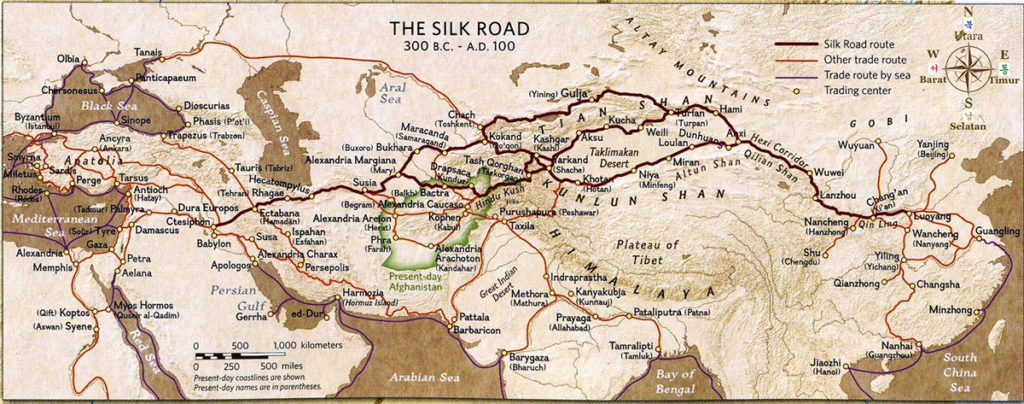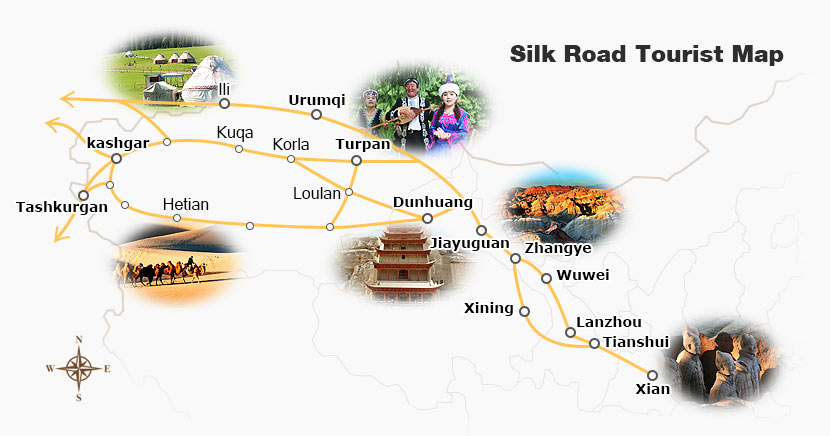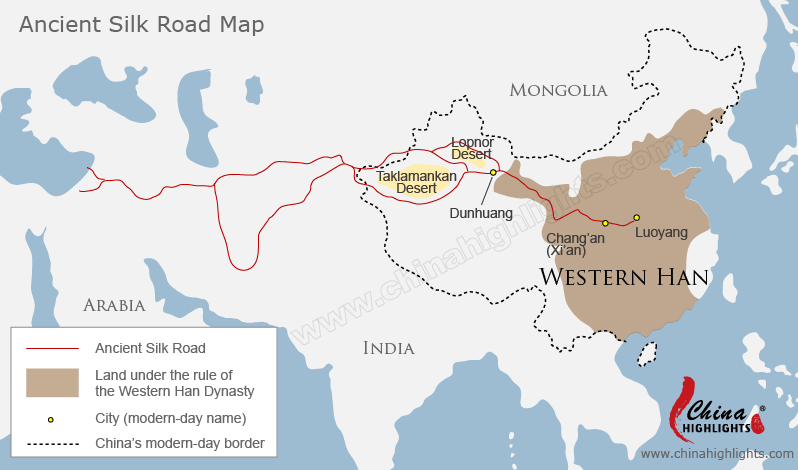
What Is the Silk Route : The Silk Route was a historic trade route that dated from the second century B.C. until the 14th century A.D. It stretched from Asia to the Mediterranean, traversing China, Persia, Arabia, Greece, and Italy. It was dubbed the Silk Route because of the heavy silk trading that took place during that period. This valuable fabric originated in China, which initially had a monopoly on silk production until the secrets of its creation spread. In addition to silk, the route facilitated the trade of other fabrics, spices, grains, fruits and vegetables, animal hides, wood and metal work, precious stones, and other items of value.
The Silk Route was a historic trade route that dated from the second century B.C. and stretched from Asia to the Mediterranean. Heavy silk was traded along the route, along with other items such as fabrics, spices, grains, fruits and vegetables, animal hides, wood and metal work, and precious stones. In 2013, China announced it was planning to restore and revive the route, connecting it with more than 60 other countries in Africa, Asia, Europe, and the Middle East.

Trade on the Road played a significant role in the development of the civilizations of China, Korea, Japan, the Indian subcontinent, Iran/Persia, Europe, the Horn of Africa and Arabia, opening long-distance political and economic relations between the civilizations. Though silk was the major trade item exported from China, many other goods were traded, as well as religions, syncretic philosophies, sciences, and technologies. Diseases, most notably plague, also spread along the Silk Road. In addition to economic trade, the Silk Road was a route for cultural trade among the civilizations along its network.
In June 2014, UNESCO designated the Chang’an-Tianshan corridor of the Silk Road as a World Heritage Site.
Name: The Silk Road derives its name from the lucrative Asian silk, a major reason for the connection of trade routes into an extensive transcontinental network. The German terms Seidenstraße and Seidenstraßen (“the Silk Road(s)”) were coined by Ferdinand von Richthofen, who made seven expeditions to China from 1868 to 1872. The term Silk Route is also used. Although the term was coined in the 19th century, it did not gain widespread acceptance in academia or popularity among the public until the 20th century. The first book entitled The Silk Road was by Swedish geographer Sven Hedin in 1938. The Silk Road derives its name from the lucrative trade in silk carried out along its length, beginning in the Han dynasty (207 BCE–220 CE). The Han dynasty expanded the Central Asian section of the trade routes around 114 BCE through the missions and explorations of the Chinese imperial envoy Zhang Qian. The Chinese took great interest in the safety of their trade products and extended the Great Wall of China to ensure the protection of the trade route.

Use of the term ‘Silk Road’ is not without its detractors. For instance, Warwick Ball contends that the maritime spice trade with India and Arabia was far more consequential for the economy of the Roman Empire than the silk trade with China, which at sea was conducted mostly through India and on land was handled by numerous intermediaries such as the Sogdians. Going as far as to call the whole thing a “myth” of modern academia, Ball argues that there was no coherent overland trade system and no free movement of goods from East Asia to the West until the period of the Mongol Empire. He notes that traditional authors discussing East-West trade such as Marco Polo and Edward Gibbon never labelled any route a “silk” one in particular.
The southern stretches of the Silk Road, from Khotan to China, were first used for jade and not silk, as long as 5000 BCE, and is still in use for this purpose. The term “Jade Road” would have been more appropriate than “Silk Road” had it not been for the far larger and geographically wider nature of the silk trade; the term is in current use in China.

Routes: The Silk Road consisted of several routes. As it extended westwards from the ancient commercial centres of China, the overland, intercontinental Silk Road divided into northern and southern routes bypassing the Taklamakan Desert and Lop Nur. Merchants along these routes where involved in “relay trade” in which goods changed “hands many times before reaching their final destinations
Reviving the Silk Route: In 2013, China began to officially restore the historic Silk Route under president Xi Jinping with a $900 billion strategy called “One Belt, One Road” (OBOR). The project was a way to improve China’s interconnectivity with more than 60 other countries in Asia, Europe, and East Africa.
Also known as the Belt and Road Initiative (BRI), it traverses numerous land and sea routes. The Silk Road Economic Belt is primarily land-based to connect China with Central Asia, Eastern Europe, and Western Europe, while the 21st Century Maritime Silk Road is sea-based, connecting China’s southern coast to the Mediterranean, Africa, South-East Asia, and Central Asia.
Visit www.dreamwaydestinations.com & www.visittobengal.com